Environmental Noise Management
MEMTECH ACOUSTICAL has specialized in the reduction of environmental noise from plants, commercial establishments and other noise sources.
Environmental Noise Control
MEMTECH ACOUSTICAL offers a variety of solutions to reduce noise being radiated to surrounding locations.
 One of the major issues confronting industrial and commercial operations is assuring compliance with state and/or local environmental noise ordinances. In addition, noise annoyance can become a problem in surrounding communities. Noise criteria in some regions are quite stringent, and can be difficult to achieve.
One of the major issues confronting industrial and commercial operations is assuring compliance with state and/or local environmental noise ordinances. In addition, noise annoyance can become a problem in surrounding communities. Noise criteria in some regions are quite stringent, and can be difficult to achieve.
MEMTECH ACOUSTICAL determines optimum solutions by considering the noise contributions of individual sound-producing sources inside and outside the plant, as well as the effects of physical location, nearby buildings and the surrounding terrain. When this information is integrated into a predictive computer model, we can determine areas of potential risk and optimize the most cost-effective design for your needs.
We utilize advanced software packages for this purpose, such as ‘Vensim’, ‘Simantics’, and our own proprietary software to provide local and distant sound level predictions. These models provide an accurate estimation of noise levels at virtually any location around a plant or other facility. Predictions can be made regarding projected sound pressure levels at various distances around the plant, and/or the probability of noise annoyance for local residents.
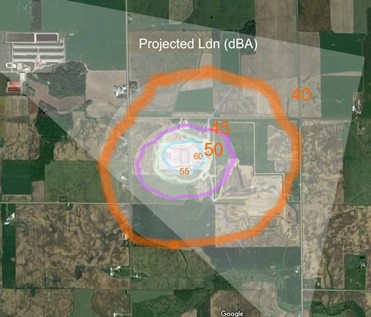 This approach also allows a comparative analysis of the effectiveness of noise barriers, walls, diffusers and other solutions prior to the purchase and construction of these structures. A “Monte-Carlo” simulation can also be developed to determine the optimum performance for various configurations, allowing a ‘dollars per decibel’ decision to be made. This assures that wall performance is maximized within your budget.
This approach also allows a comparative analysis of the effectiveness of noise barriers, walls, diffusers and other solutions prior to the purchase and construction of these structures. A “Monte-Carlo” simulation can also be developed to determine the optimum performance for various configurations, allowing a ‘dollars per decibel’ decision to be made. This assures that wall performance is maximized within your budget.
Noise enclosures can also be used for both indoor and outdoor equipment, and can include ventilation ports and maintenance access doors. Enclosure information can be found here.
Noise Barrier Walls
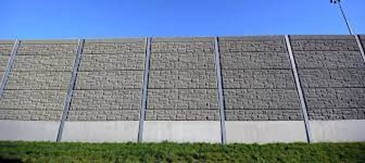 While it is always best to minimize noise levels at the source, this is often impossible due to cost and/or the physical properties of the equipment. Noise barrier walls, also known as sound barrier walls or acoustic barriers, are structures designed to reduce the transmission of noise from one area to another. They are typically erected along highways, railways, or other noisy environments to mitigate the impact of noise pollution on nearby communities or sensitive areas.
While it is always best to minimize noise levels at the source, this is often impossible due to cost and/or the physical properties of the equipment. Noise barrier walls, also known as sound barrier walls or acoustic barriers, are structures designed to reduce the transmission of noise from one area to another. They are typically erected along highways, railways, or other noisy environments to mitigate the impact of noise pollution on nearby communities or sensitive areas.
MEMTECH ACOUSTICAL offers a variety of noise walls and barriers that can be used to reduce noise that is radiated to surrounding locations. They are available in permanent or temporary configurations. We also specialize in the design and construction of splayed walls, which provide significant attenuation of environmental noise with a greatly reduced wall height. See description below.
These considerations should be taken into account when designing and building noise barriers:
Structure: Noise barrier walls are usually constructed as solid, continuous barriers made of materials with good sound-absorbing properties. Common materials include concrete, wood, metal, or composite materials.
Height and Length: The height and length of noise barrier walls vary depending on the specific requirements of the site. The height is determined based on the distance between the noise source and the receptor (e.g., residential area). Taller barriers are generally more effective at reducing noise, .
Design: The design of noise barrier walls takes into account both functionality and aesthetics. The walls may have different surface patterns or textures to help disperse sound waves and minimize reflections. Some designs incorporate openings or perforations to allow for airflow while still reducing noise transmission.
Sound level and frequency content of the noise source(s): This is a critical parameter, as it will determine most effective type of barrier or wall to achieve the desired performance. If this data is not available, MEMTECH ACOUSTICAL can assist by contacting equipment OEM’s and/or making on-site measurements of comparable equipment. Without a complete understanding of noise source characteristics, attempting to design an effective noise-control barrier becomes ‘guesswork’, often resulting in poor performance.
The desired ‘target’ levels of noise at the surrounding locations. This may simply be the noise ordinance requirements of the community or county, or may involve minimizing subjective noise annoyance (e.g. sustained tones, fan noise, etc.) for local residents.
Sound Transmission Class (STC): The sound insulation performance of noise barrier walls is measured using the Sound Transmission Class rating system. Higher STC values indicate better sound reduction. Different materials and designs can achieve varying STC ratings.
Placement and Positioning: Noise barrier walls are strategically positioned between the noise source and the sensitive area to provide maximum noise reduction. Factors such as topography, distance, and line of sight are considered during placement to optimize their effectiveness.
Maintenance: Noise barrier walls generally require minimal maintenance. Periodic inspections may be necessary to identify any damage, such as cracks or structural issues, and address them promptly to ensure optimal performance.
The topography of the surrounding areas. Restrictions on wall placement locations, based on property lines, interference with utilities (water lines, roads, etc.), access to equipment, etc.
Community building code restrictions.
The need to control internal reflections from the walls (which may simply reflect the noise from one area to another).
It’s important to note that while noise barrier walls can significantly reduce noise levels, they do not eliminate noise entirely. Effectiveness depends on various factors, including the source of noise, frequency characteristics, and the surrounding environment.
Executing an effective noise barrier installation can be a complex process, but MEMTECH ACOUSTICAL provides complete ‘turn-key’ installations, along with necessary engineering, permitting, construction planning and installation for virtually any application.
As stated above, six types of noise barrier walls are available:
Composite Concrete Acoustic Walls
 A composite concrete wall refers to a type of wall structure that combines two or more different materials to create a unified system with improved properties. Composite materials are often used to enhance acoustic characteristics along with improved strength, and aesthetics.
A composite concrete wall refers to a type of wall structure that combines two or more different materials to create a unified system with improved properties. Composite materials are often used to enhance acoustic characteristics along with improved strength, and aesthetics.
These walls provide the best overall acoustic performance for most applications. They consist of pre-cast sections, which are supported by steel posts. The sections then slide-in between the supporting posts, and then act as a permanent, durable and effective barrier. They can be produced with heights up to 25 feet. Angled reflective ‘splays’ can be added on the top of the walls to improve performance when dealing with difficult noise problems. These walls are not susceptible to corrosion and do not typically require any maintenance. They are very durable and weatherproof.
These walls also serve to absorb noise on the inner surfaces, which will minimize reflections back to the source. Composite concrete walls are often the only viable choice when low-frequency noise content must be reduced. Different designs are available. Access doors can be added if required.
Aluminum Walls
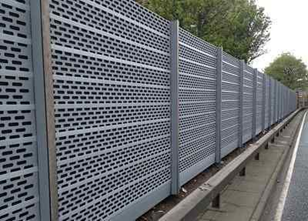 Aluminum walls are lighter than the concrete walls detailed above. They typically consist of multi-layer ported aluminum panels filled with sound-absorbing materials and provide good overall performance, Walls which are ‘crash-resistant’ can be supplied for roadways and other areas where vehicle impact is a concern. They are resistant to corrosion and are very durable, even under severe conditions. Minimal maintenance is required. In addition, they are fully recyclable when their functional life has ended.
Aluminum walls are lighter than the concrete walls detailed above. They typically consist of multi-layer ported aluminum panels filled with sound-absorbing materials and provide good overall performance, Walls which are ‘crash-resistant’ can be supplied for roadways and other areas where vehicle impact is a concern. They are resistant to corrosion and are very durable, even under severe conditions. Minimal maintenance is required. In addition, they are fully recyclable when their functional life has ended.
Aluminum walls are offered in a single or double-sided noise absorption configuration for applications where internal noise reflection must be minimized. Doors are easily added, along with transparent sections where visibility is required. Angled reflective ‘splays’ can be added on the top of the walls to resolve difficult noise problems.
PVC/Vinyl Walls
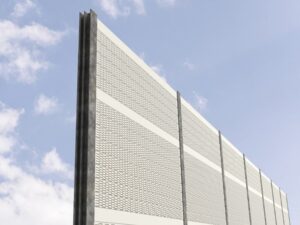 Sound walls made from PVC or Vinyl offer an economical alternative to concrete or aluminum. Vinyl walls are the lightest of all acoustic barriers, and are typically used when weight is a critical factor. They are most effective at higher frequencies, and can be used for rooftop applications. These walls are typically made from durable, weather-resistant materials that can withstand exposure to harsh environmental conditions, including UV rays, moisture, and temperature variations. They are designed to maintain their structural integrity and aesthetic appearance over time.
Sound walls made from PVC or Vinyl offer an economical alternative to concrete or aluminum. Vinyl walls are the lightest of all acoustic barriers, and are typically used when weight is a critical factor. They are most effective at higher frequencies, and can be used for rooftop applications. These walls are typically made from durable, weather-resistant materials that can withstand exposure to harsh environmental conditions, including UV rays, moisture, and temperature variations. They are designed to maintain their structural integrity and aesthetic appearance over time.
PVC/Vinyl noise walls offer a variety of design options in terms of colors, patterns, and textures. They can be customized to blend with the surrounding environment or match specific architectural requirements, enhancing the visual appeal of the barrier.
PVC/Vinyl noise walls generally require minimal maintenance. Periodic cleaning to remove dirt, debris, or graffiti may be necessary to keep the walls in good condition. These walls do not require painting or refinishing. Doors and windows are easily added. Long-term durability is excellent, and a variety of colors are available.
Reinforced vinyl curtains can also be used for noise control barriers on a permanent or temporary basis.
Splayed Walls
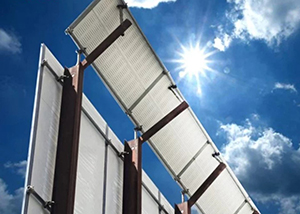 A splayed wall, also known as a flared wall or angled wall, refers to a wall that is inclined or angled rather than being perpendicular to the ground. It means that the wall is sloped or tilted outward or inward instead of being vertical or parallel to adjacent surfaces. Splays are added to sound walls for difficult applications where noise attenuation must be maximized. They act to reduce diffraction of sound waves above the walls by reflecting some of the acoustic energy (which may be diffracted above the top) back to the source.
A splayed wall, also known as a flared wall or angled wall, refers to a wall that is inclined or angled rather than being perpendicular to the ground. It means that the wall is sloped or tilted outward or inward instead of being vertical or parallel to adjacent surfaces. Splays are added to sound walls for difficult applications where noise attenuation must be maximized. They act to reduce diffraction of sound waves above the walls by reflecting some of the acoustic energy (which may be diffracted above the top) back to the source.
Splays can be added to both concrete and aluminum walls. The angle and height of the splay is designed based on the desired noise attenuation and the frequency content of the noise source(s).
Acoustic Facings
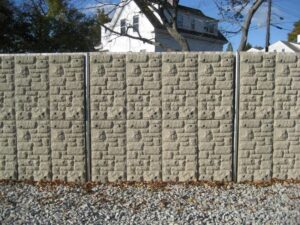 Acoustic facings are materials or coverings used to enhance the sound-absorbing properties of wall or building surfaces. They are designed to reduce the reflection of sound waves and improve acoustic performance in various environments, For situations where basic masonry or brick walls currently exist, the noise absorption characteristics can be greatly improved by the use of acoustic facings, which are modular elements attached to the current wall structures.
Acoustic facings are materials or coverings used to enhance the sound-absorbing properties of wall or building surfaces. They are designed to reduce the reflection of sound waves and improve acoustic performance in various environments, For situations where basic masonry or brick walls currently exist, the noise absorption characteristics can be greatly improved by the use of acoustic facings, which are modular elements attached to the current wall structures.
Here are some common types of acoustic facings:
Perforated Panels: Perforated panels have small holes or perforations on their surface, allowing sound waves to pass through and be absorbed by the underlying sound-absorbing material. The perforations are strategically designed to optimize sound absorption while maintaining structural integrity. These panels are often used in applications where both sound absorption and aesthetic considerations are important.
Metal Panels: Metal panels with perforations or surface treatments can also serve as acoustic facings. They are commonly used in applications where a combination of durability, aesthetics, and sound absorption is required. Metal panels are often used in high-traffic areas, such as airports or sports facilities.
They can be selected based on the desired aesthetic, acoustic performance, and specific requirements of the space. Proper placement, coverage, and the selection of suitable materials are crucial for achieving optimal acoustic results. Acoustic Facings are well-suited for retrofit situations or new construction, and offer economical solutions without the need to construct barrier walls. A variety of designs are available.
Temporary Noise Barriers
Temporary noise barriers, also known as portable noise barriers, are structures used to mitigate noise on a short-term basis. They are typically deployed in construction sites, outdoor events, roadwork zones, or any situation where noise control is needed for a limited duration.
These barriers usually consist of flexible noise ‘curtains’ supported by a tubular framework, which can easily be installed and torn-down. Or they can be added to existing fencing. They are economical and can easily be re-used for future projects. They are lightweight and resistant to environmental elements. Windows and/or access openings are easily integrated into the design.
Temporary noise barriers are designed to be portable, easy to install, and dismantle, allowing for flexibility in noise control applications. They provide relief from noise pollution, protect nearby communities or sensitive areas, and create a more comfortable environment during construction or other short-term events. The specific choice of temporary noise barriers depends on factors such as the noise source, noise levels, duration of use, and site requirements.
As is the case with any noise barrier system, these temporary barriers must be specified, designed and installed based on the noise source levels and frequency content, as well as the desired noise ‘targets’ in nearby areas.
Wall and Barrier Ratings
There are a number of rating systems used to quantify the effectiveness of noise barriers, and they can be confusing.
STC or Sound Transmission Class is a rating system used to measure the effectiveness of a wall or barrier in reducing noise from one side to the other. The higher the number, the more effective the wall is in reducing noise; however the measurements are determined by comparing the actual measured readings against a pre-determined ‘contour’ curve. The measurements are not in decibels (dB), so it is not correct to assume that a wall with a rating of STC 30 will reduce a 90 dBA noise source on one side to 60 dBA on the other. STC ratings do not take into account low frequency noise, which is often radiated from industrial machinery and heavy truck traffic, nor does it consider effects such as diffraction over and around a wall, or gaps at doors or joints. Therefore it is not advisable to use “STC” as the sole determination in selecting the right product for a specific application.
NRC or Noise Reduction Coefficient measures the noise absorption characteristics of a wall or barrier. This will determine how much noise is reflected back to the source, and how much will be directly absorbed into the wall. NRC ratings range from 0.0 (100% reflective) to above 1.0 (near 0% reflective); however these ratings consider noise only within the range of 200 Hz. to 2500 Hz., and do not take into account all factors, such as noise reflection from the ground or the angle of incidence between the source. They do not ensure that a particular barrier or wall will effectively control noise reflection for a given application. As is the case with “STC” ratings, it is not advisable to use “NRC” as the sole determining factor in selecting the right product for a specific application.
As noted above, it is critical to assure that any noise wall or barrier be specified, designed and installed to be effective at attenuating the source noise frequencies for the specific application, and that the design will be adequate to meet the necessary noise target(s) in surrounding areas. In addition, considerations must be included for maintenance access, building codes, utility lines or pipes, and community aesthetic requirements. MEMTECH ACOUSTICAL has the engineering expertise to select the correct products, necessary dimensions/location, and proper installation process to assure that your noise requirements are met in the most cost-effective manner possible. We provide ‘turn-key’ solutions, and will work with your engineering or architectural teams as required to meet your goals.
Contact Memtech Acoustical
If you have a specific request, special project, or need specifications about our complete range of high-performance noise control applications, our team is ready to answer your questions.
